
Reforestation is the natural or intentional restocking of existing forests and woodlands (forestation) that have been depleted, usually through deforestation but also after clearcutting. Two important purposes of reforestation programs are for harvesting of wood or for climate change mitigation purposes.
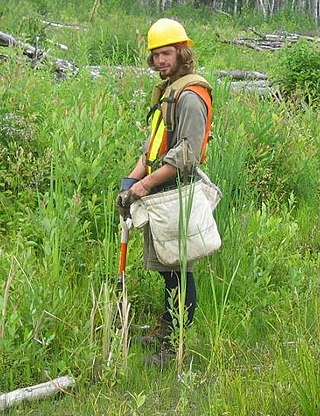
Tree planting is the process of transplanting tree seedlings, generally for forestry, land reclamation, or landscaping purposes. It differs from the transplantation of larger trees in arboriculture and from the lower-cost but slower and less reliable distribution of tree seeds. Trees contribute to their environment over long periods of time by providing oxygen, improving air quality, climate amelioration, conserving water, preserving soil, and supporting wildlife. During the process of photosynthesis, trees take in carbon dioxide and produce the oxygen we breathe.

Pinus contorta, with the common names lodgepole pine and shore pine, and also known as twisted pine, and contorta pine, is a common tree in western North America. It is common near the ocean shore and in dry montane forests to the subalpine, but is rare in lowland rain forests. Like all pines, it is an evergreen conifer.

The blue spruce, also commonly known as green spruce, Colorado spruce, or Colorado blue spruce, is a species of spruce tree. It is native to North America, and is found in USDA growing zones 1 through 7. It is found naturally in Arizona, Colorado, Idaho, New Mexico, Utah and Wyoming. It has been widely introduced elsewhere and is used as an ornamental tree in many places far beyond its native range. The blue spruce has blue-green colored needles and is a coniferous tree.
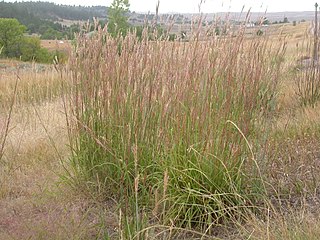
Andropogon gerardi, commonly known as big bluestem, is a species of tall grass native to much of the Great Plains and grassland regions of central and eastern North America. It is also known as tall bluestem, bluejoint, and turkeyfoot.

Ecological restoration is the process of assisting the recovery of an ecosystem that has been degraded, damaged, or destroyed. It is distinct from conservation and preservation in that it is an "attempt to co-design nature with nonhuman collaborators." Ecological restoration can reverse biodiversity loss, combat climate change, and support local economies. The United Nations named 2021-2030 the Decade on Ecosystem Restoration.

Asclepias syriaca, commonly called common milkweed, butterfly flower, silkweed, silky swallow-wort, and Virginia silkweed, is a species of flowering plant. It is native to southern Canada and much of the United States east of the Rocky Mountains, excluding the drier parts of the prairies. It is in the genus Asclepias, the milkweeds. It grows in sandy soils as well as other kinds of soils in sunny areas.

The University of Wisconsin–Madison Arboretum is a teaching and research facility of the University of Wisconsin–Madison and the site of historic research in ecological restoration. In addition to its 1,260 acres (5 km2) in Madison, Wisconsin, the Arboretum also manages 520 acres (210 ha) of remnant forests and prairies throughout Wisconsin. It was designated a National Historic Landmark in 2021, in recognition for its role as a pioneer in the field of ecological restoration.

Forest protection is a branch of forestry which is concerned with the preservation or improvement of a forest and prevention and control of damage to forest by natural or man made causes like forest fires, plant pests, and adverse climatic conditions.
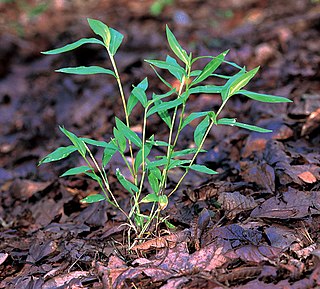
Microstegium vimineum, commonly known as Japanese stiltgrass, packing grass, or Nepalese browntop, is an annual grass that is common in a wide variety of habitats and is well adapted to low light levels. It has become an invasive species throughout parts of the world, most notably North America.

The Lilly Arbor Project is a part of an experimental riparian floodplain reforestation and ecological restoration program, located along the White River in Indianapolis, Indiana, in the eastern United States.

Wetland conservation is aimed at protecting and preserving areas of land including marshes, swamps, bogs, and fens that are covered by water seasonally or permanently due to a variety of threats from both natural and anthropogenic hazards. Some examples of these hazards include habitat loss, pollution, and invasive species. Wetland vary widely in their salinity levels, climate zones, and surrounding geography and play a crucial role in maintaining biodiversity, ecosystem services, and support human communities. Wetlands cover at least six percent of the Earth and have become a focal issue for conservation due to the ecosystem services they provide. More than three billion people, around half the world's population, obtain their basic water needs from inland freshwater wetlands. They provide essential habitats for fish and various wildlife species, playing a vital role in purifying polluted waters and mitigating the damaging effects of floods and storms. Furthermore, they offer a diverse range of recreational activities, including fishing, hunting, photography, and wildlife observation.

Invasive species are a significant threat to many native habitats and species of the United States and a significant cost to agriculture, forestry, and recreation. The term "invasive species" can refer to introduced/naturalized species, feral species, or introduced diseases. Some introduced species, such as the dandelion, do not cause significant economic or ecologic damage and are not widely considered as invasive. Economic damages associated with invasive species' effects and control costs are estimated at $120 billion per year.

Akira Miyawaki was a Japanese botanist and an expert in plant ecology who specialized in seeds and natural forests. He was active worldwide as a specialist in natural vegetation restoration of degraded land.

Asclepias viridis is a species of milkweed, a plant in the dogbane family known by the common names green milkweed, green antelopehorn and spider milkweed. The Latin word viridis means green. The plant is native to the midwestern, south central and southeastern United States, as well as to the southeastern portion of the western United States.
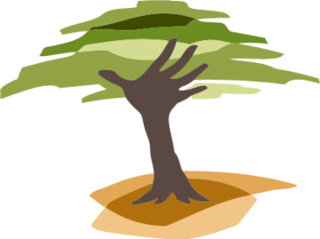
Eden Reforestation Projects (Eden) is a nonprofit NGO that works in developing countries to rebuild natural landscapes destroyed by deforestation. Eden works directly with communities experiencing extreme poverty resulting from the deforestation and destruction of the land that sustains them. The organization employs thousands of local community members and provides them with the education and tools necessary to plant, grow, and protect to maturity, millions of trees each year. Eden currently plants approximately 15 million trees a month, and in 2020 reached over 423 million trees planted of which over 225 million are mangrove trees.

Assisted migration is the movement of populations or species by humans from one territory to another in response to climate change. This is the definition offered in a nontechnical document published by the United States Forest Service in 2023, suggesting that this form of climate adaptation "could be a proactive, pragmatic tool for building climate resilience in our landscapes."

The Torreya Guardians is a self-organized group of conservationists dedicated to facilitating the assisted migration of the Florida torreya by rewilding it further north than its native range in Florida and Georgia. Founded in the early 2000s, the group is often mentioned as an instigator of the assisted migration of forests in North America for conservation and climate adaptation purposes. It is an example of citizen-initiated citizen science.
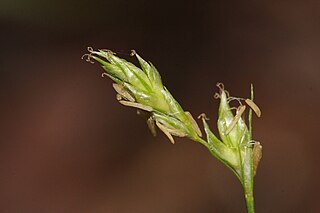
Carex deweyanaDewey's sedge, short-scale sedge, is a species of sedge native to Canada and the United States.

Carex retrorsa, the knotsheath sedge, deflexed bottlebrush sedge, or retrorse sedge, is a widespread species of flowering plant in the family Cyperaceae, native to southern Canada and the northern United States. Preferring wet areas and tolerant of some shade, it is available from speciality nurseries for such uses as ecological restoration projects, erosion control, and rain gardens.




















